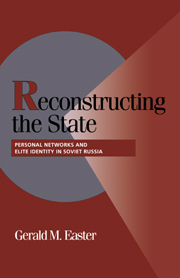Book contents
- Frontmatter
- Contents
- Preface
- 1 Introduction: Explaining State-Building Outcomes and the Soviet Russian Case
- Part I Structure and Identity in the Postrevolutionary State Elite
- Part II Informal Sources of Power in the Postrevolutionary State
- 4 Extending the Reach of the State: Personal Networks and Territorial Administration
- 5 The Constraints of Power: Personal Networks and Central Rulership
- Part III Intrastate Conflict and the Constraints of Power Redefined
- Notes
- Bibliography
- Index
- Titles in the series
4 - Extending the Reach of the State: Personal Networks and Territorial Administration
Published online by Cambridge University Press: 13 October 2009
- Frontmatter
- Contents
- Preface
- 1 Introduction: Explaining State-Building Outcomes and the Soviet Russian Case
- Part I Structure and Identity in the Postrevolutionary State Elite
- Part II Informal Sources of Power in the Postrevolutionary State
- 4 Extending the Reach of the State: Personal Networks and Territorial Administration
- 5 The Constraints of Power: Personal Networks and Central Rulership
- Part III Intrastate Conflict and the Constraints of Power Redefined
- Notes
- Bibliography
- Index
- Titles in the series
Summary
How did the new Bolshevik state, in less than a decade, develop its capacity for territorial administration and extend its reach across its expansive regions? Extending the reach of the new Bolshevik state beyond the central industrial region to the rural and multiethnic periphery presented a daunting task. The revolutions of 1917 had severed the formal bureaucratic lines which long connected center to periphery in the old regime. Although the Red Army reclaimed most of the territory of the former tsarist empire, the institutions of regional administration could not simply be reoccupied, but had to be rebuilt. The new state was constrained in this effort by an acute shortage of trained personnel, broken lines of communication and transportation, and the uncooperativeness and at times outright hostility of the local populations.
The study contends that personal network ties played a more significant role in the state-building process than has previously been recognized by Western scholars. The argument does not assert that formal organization and coercion were not important to the process of postrevolutionary state building, but rather that these factors alone do not explain the outcome. The intersection of informal and formal structures enabled the weak postrevolutionary state to develop a capacity for territorial administration.
This chapter shows how personal network ties intersected with formal organizational structures in a way that significantly strengthened the new state's poorly developed infrastructural powers.
- Type
- Chapter
- Information
- Reconstructing the StatePersonal Networks and Elite Identity in Soviet Russia, pp. 67 - 88Publisher: Cambridge University PressPrint publication year: 2000



